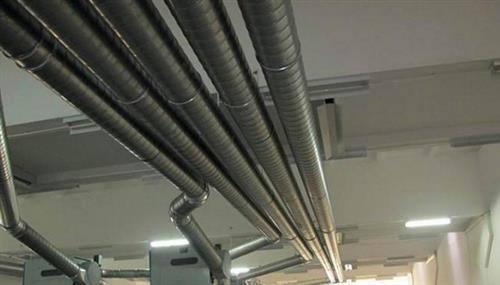沉浸式了解山东通风管道制作流程
来源:http://www.jntfgd.com 日期:2025-07-11 发布人:创始人
山东通风管道作为建筑通风系统的核心部件,其制作流程需兼顾密封性、强度与适配性,从材料甄选到成型安装,每个环节都影响着最终的通风效果。
As the core component of building ventilation systems, the production process of Shandong ventilation ducts needs to consider sealing, strength, and adaptability. From material selection to molding and installation, each link affects the final ventilation effect.
材料裁剪是制作的基础环节。根据设计图纸确定管道尺寸后,选用镀锌钢板(厚度按风管尺寸匹配,一般直径≤300mm 选用 0.5-0.8mm 厚钢板,直径较大时选 1.0-1.2mm),通过激光切割机或剪板机按标线精准裁剪。裁剪时需预留咬口余量(通常为 10-15mm),确保后续拼接严密。对于弧形或异形管道,需在钢板上划出折角线,用折边机按角度弯折,折角误差控制在 ±1° 内,保证管道弧度平滑。
Material cutting is the fundamental step in production. After determining the pipeline size according to the design drawings, galvanized steel plates are selected (with a thickness matched according to the size of the air duct, generally 0.5-0.8mm thick steel plates are selected for diameters ≤ 300mm, and 1.0-1.2mm for larger diameters), and accurately cut according to the markings using laser cutting machines or shearing machines. When cutting, it is necessary to reserve a bite allowance (usually 10-15mm) to ensure tight splicing in the future. For curved or irregular pipelines, it is necessary to draw corner lines on the steel plate and use a folding machine to bend them according to the angle. The bending error should be controlled within ± 1 ° to ensure smooth curvature of the pipeline.
咬口成型是保证密封性的关键。采用联合角咬口或按扣式咬口工艺,将裁剪后的钢板边缘折成特定形状,通过咬口机加压使接口相互咬合。圆形风管多采用插接式咬口,矩形风管则用转角咬口,咬口处需平整无褶皱,咬合深度均匀(一般为 8-10mm),避免因咬合不严导致漏风。对于高压系统风管,咬口后还需在接口处涂抹密封胶,增强气密性。
Bite forming is the key to ensuring sealing. Using joint corner biting or snap on biting technology, the edges of the cut steel plate are folded into a specific shape, and the interfaces are pressed together by a biting machine. Circular ducts often use plug-in bite points, while rectangular ducts use corner bite points. The bite points should be flat and wrinkle free, with a uniform depth of bite (usually 8-10mm), to avoid air leakage caused by loose bite points. For high-pressure system ducts, sealant should be applied at the interface after biting to enhance air tightness.
法兰装配决定管道连接的稳定性。按风管尺寸预制角钢法兰(角钢规格根据风管尺寸选择,如 300×200mm 风管配 L30×3 角钢),用铆钉将法兰固定在风管端部,铆钉间距控制在 100-150mm,且分布均匀。法兰平面需与风管轴线垂直,偏差不超过 2mm,否则会导致安装时接口错位。安装前检查法兰平整度,用直角尺校准,确保连接面紧密贴合。
Flange assembly determines the stability of pipeline connections. Prefabricate angle steel flanges according to the size of the air duct (angle steel specifications are selected according to the size of the air duct, such as L30 × 3 angle steel for 300 × 200mm air ducts), and fix the flanges at the end of the air duct with rivets. The rivet spacing should be controlled between 100-150mm and evenly distributed. The flange plane should be perpendicular to the axis of the air duct, with a deviation of no more than 2mm, otherwise it may cause interface misalignment during installation. Before installation, check the flatness of the flange and calibrate it with a square ruler to ensure that the connecting surface is tightly fitted.

管道加固针对长距离或大尺寸风管。当风管长度超过 10m 或直径大于 800mm 时,需加装加固筋(采用同材质钢板条或角钢),加固筋间距 1.5-2m,通过焊接或铆接固定在风管外壁,增强抗风压能力。对于矩形风管,可在内部加装横撑,防止风压过大导致管壁变形,横撑两端与法兰连接牢固,确保整体刚度。
Pipeline reinforcement is designed for long-distance or large-sized air ducts. When the length of the air duct exceeds 10 m or the diameter is greater than 800 mm, it is necessary to install reinforcement bars (steel plates or angle steels of the same material) with a spacing of 1.5-2 m, which are fixed on the outer wall of the air duct by welding or riveting to enhance the wind pressure resistance. For rectangular ducts, cross braces can be installed internally to prevent deformation of the duct wall caused by excessive wind pressure. The ends of the cross braces are firmly connected to the flanges to ensure overall rigidity.
密封与防腐处理提升耐用性。风管成型后,用密封胶封堵咬口缝、铆钉孔等易漏点,胶层厚度均匀(0.5-1mm),固化后形成连续密封层。在潮湿环境使用的风管,需进行防腐处理:先清除表面油污锈迹,涂刷两遍防锈漆,干燥后再涂面漆,漆膜厚度达 60-80μm,避免锈蚀影响使用寿命。
Sealing and anti-corrosion treatment enhance durability. After the air duct is formed, use sealant to seal the bite joints, rivet holes, and other easily leaking points. The adhesive layer should have a uniform thickness (0.5-1mm) and form a continuous sealing layer after curing. Ducts used in humid environments require anti-corrosion treatment: first remove surface oil and rust stains, apply two coats of anti rust paint, dry and then apply topcoat, with a film thickness of 60-80 μ m, to avoid rust affecting the service life.
质检与安装前调试不可或缺。对成型风管进行压力测试,将风管两端封堵后通入压缩空气(压力 0.5-1.0kPa),30 分钟内压力下降不超过 5% 即为合格。检查风管外观,确保表面平整、无明显变形,法兰螺栓孔位置对应准确。最后按编号堆放,避免挤压变形,为现场安装做好准备。
Quality inspection and pre installation commissioning are indispensable. Perform pressure testing on the formed air duct, seal both ends of the duct and introduce compressed air (pressure 0.5-1.0kPa). If the pressure drops by no more than 5% within 30 minutes, it is considered qualified. Check the appearance of the air duct to ensure that the surface is flat, without obvious deformation, and that the flange bolt hole positions correspond accurately. Finally, stack them according to their numbers to avoid squeezing and deformation, and prepare for on-site installation.
本文由济南通风管道友情奉献.更多有关的知识请点击:http://www.jntfgd.com真诚的态度.为您提供为全面的服务.更多有关的知识我们将会陆续向大家奉献.敬请期待.
This article is a friendly contribution from Shandong Ventilation Duct For more information, please click: http://www.jntfgd.com Sincere attitude To provide you with comprehensive services We will gradually contribute more relevant knowledge to everyone Coming soon.
上一篇:长期不清理的通风管道不敢想有多脏,那要怎么清理呢?本站图片均由网站所有方提供,部分图片来源于网络,如有任何疑问请及时与我们联系,未经沟通本站不承担相关法律责任!